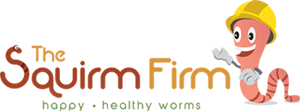- Citrus fruit matter should be used in moderation. Too much citrus is a bad thing for Red Wigglers.
- In addition, your worms will appreciate some fiber with their veggies. Shredded newspaper and paper towels, along with cardboard is a good choice. Use common sense, and don’t pile in too much paper.
It is important to chop the food waste into very small pieces, as the Red Wigglers have no teeth to help them grind through larger chunks of food.
It is also a good idea to consider adding some paper products at the same time you add any moist food products to your worm bedding to help absorb the excess water contained in the food. You don’t want your habitat to get too moist, because overly moist conditions can lead to pests and an unpleasant odor in your worm bin.
Coffee grounds and tea bags, and ground up egg shells (in moderation) are good add-ins, and aged animal manure can be added judiciously. Be careful not to over-do it and upset the delicate balance of the worm bin, however.
Starchy foods, like breads, potatoes. pasta and rice, can be scarcely used, but this is a risky step best avoided by beginners. The best course is to stick with the basics, and practice moderation when adding variety to the worm menu.
There are some things you will want to avoid at all cost.
Stay away from dairy and meats, and oils or greases. Obviously, harsh chemicals and non-biodegradable materials are problematic, as are human and pet waste. Once again, common sense is the best practice.
Other tips to consider:
Let your waste material sit for a while, allowing it to degrade a bit before adding it in. The worms really don’t munch on the carrot peels and pepper slices. Instead, they are noshing on a microbial slime that forms on the rotting matter.
This is a little strategy that pays big dividends.
You might consider purchasing a compost pail to collect kitchen waste and other organic matter, where you can let it simmer and ferment for a few days while the microbial colonization process begins to take place.
Now that I’ve shown you how to feed a hungry bunch of composting worms, I’d like to hear what kinds of food your little guys enjoy the most. Tell us in the comments section below!
Article by Donny B


are onions safe ?
Hi Jack. Onions are a safe food to offer your worms. They do however smell terrible as they decompose and are therefore best to be used in an outdoor worm composting situation. If it’s possible, cook onions (without salt or oils) so that they can be consumed more quickly.
When you feed, should it be in one corner like you would for a hamster? or do you mix it with the bedding and add it all over the box?